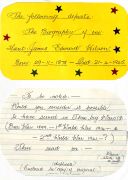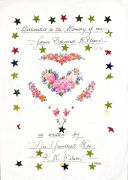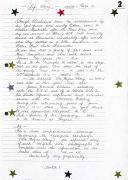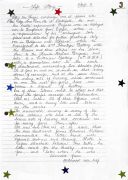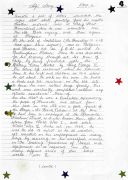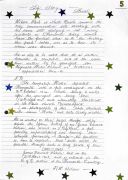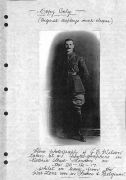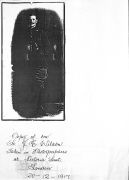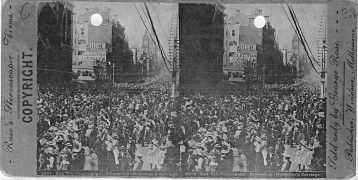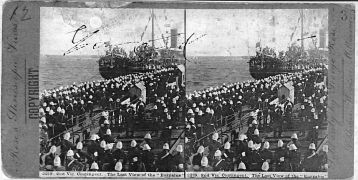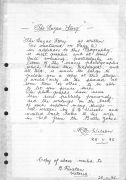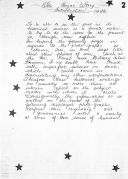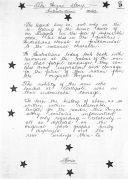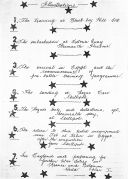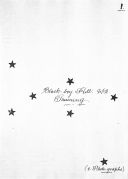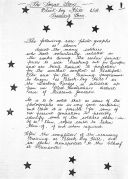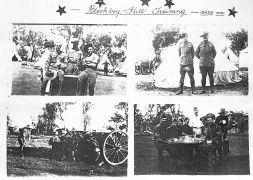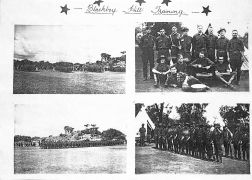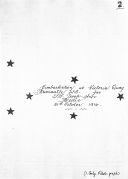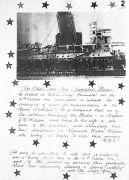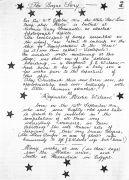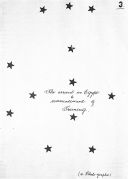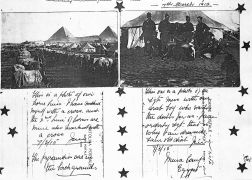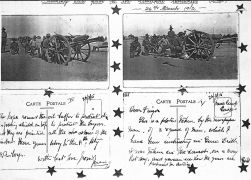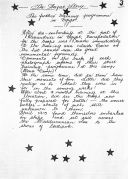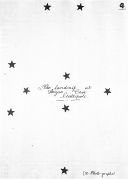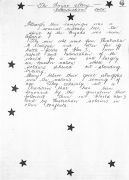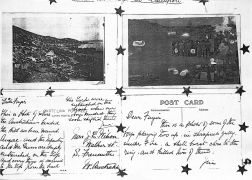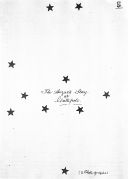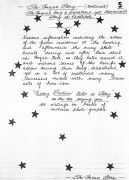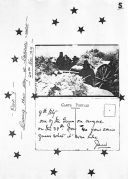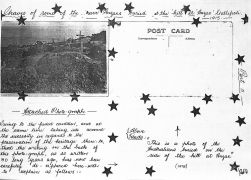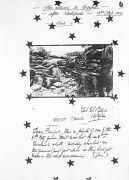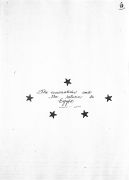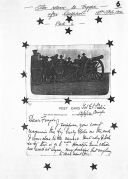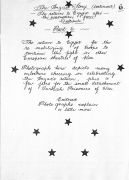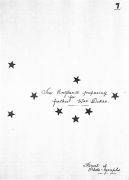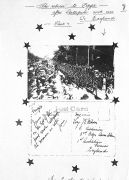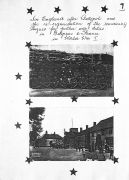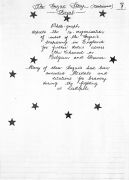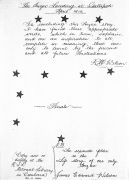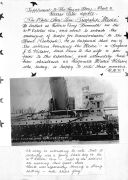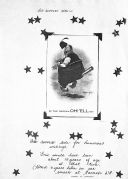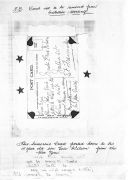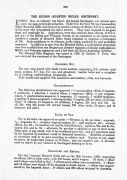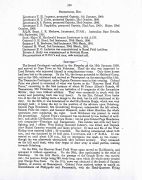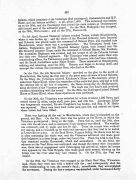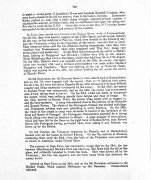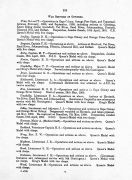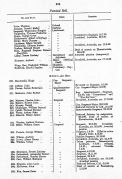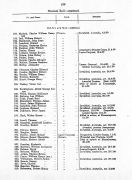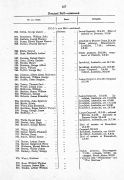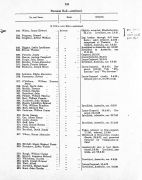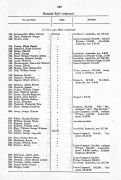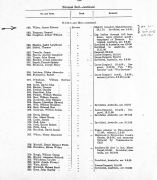WILSON, James Edward - 282
| Original items held by the Army Museum of Western Australia |
| Conflict | Second Anglo-Boer War World War 1 |
|---|---|
| Service Arm | Australian Imperial Force |
| Unit | 2nd Victorian Mounted Rifles Garrison Artillery 6th Field Artillery Battery |
| Service No. | 282 |
| Service Arm | Army |
| Date of Birth | 29 November 1878 |
| Date of Death | 21 April 1945 |
| Relatives | Son - R.M.Wilson |
Handwritten biography compiled by the youngest son, Reginald Medic Wilson, in 1995.
The following depicts the Biography of one:
Lieut. James Edward Wilson.
Born: 29-11-1878 - Died: 21-4-1945.
as written by his youngest son-R.W. Wilson-1995
The Life Story of our particular Anzac, James Edward Wilson, 1878 - 1945
He was born on the 29th Nov. 1878 at Winchelsea in Victoria, where he spent the earliest part of his life, and was educated at primary and
high schools (Geelong). There was a certain amount of Scottish heritage in his blood.
It was during his late teenage period of his life that he met a young lady (Harriet Ann Graylard) of the same age (Born 6th April 1879) from
a nearby town of Colac, whom he eventually married.
It was, that, not many knew, that he was born a fighter, and at the same time, one who distinguished himself with exploits of daring in two
big wars, and to a certain degreee, assisted in many respects, in the Second World War!
However, let us commence from the period in the year 1899 when from Geelong in Victoria, he enlisted with the Victorian Mounted Rifles Unit
under the command of a Colonel Tom Price. He longed for scrap and adventure, and as a youth of 20 years of age, answered the call to arms
for Service in the Boer war in South Africa. He participated in five scraps during the campaign which entitled him to the Queens Medal and
five clasps.
It was during one period of fighting at Reitfontein, near Pretoria, that stray Boer bullet, probably meant for General Cunningham, who was
standing nearby, caught him as he was near his horse. He hurled an impreciation at his steed for so dis-loyally administering a kick to his
master when at a disadvantage, but a glance at his gory leg told him that a bigger kick had come to him!
Though Winchelsea born, he, accompanied by his girl friend from nearby Colac, came to Western Australia after the Boer War, where they were
married at Albany W.A. and eventually arrived at Fremantle immediately afterwards where they settled in a little residence in Walker Street
South Fremantle.
It was here that a family of four sons and three daughters were born and reared between the years 1901-1914.
It is to be brought to notice at this stage that in the year 1914 when the last of the family was born - a son - on the 12th September 1914
- relates to:-- see separate 'The Anzac Story' as told and also in this year (1914) saw James Edward Wilson enlisting with the B.A.C. and off the World War I.
The South African experience and volunteer service with the Garrison Artillery during the intervening years of peace (1900-1914) stood him
in good stead. He was appointed Sergeant to 'C' Sub-Section of his company, later to be known as 'Anzacs'.
NB
For a more comprehensive coverage concerning the Gallipoi campaign (The Anzac Story) see separate story of such, complete with photographs &
complete with the information on the backs there-of, all in all, describing very graphically.
After the Anzac campaign over at places like Pine Ridge, Lone Pine, etc. at Gallipoli, he and his battle experienced Anzacs were re-deployed
over to England from Egypt, where a re-organisation of his contingent took place and detailed for further grueling duty over in Belgium and
France, where he transferred to the 3rd Howitzer Battery with the Crown and three stripes on his sleeve, then to the French Mortar Brigade,
and later to a Victorian Battery (6th A.F.A.) with a promotion to the rank of Lieutenant, warranting two shoulder pips.
So it goes on and on, so much so, that many stories of carnage, and at the same time, the many acts of bravery, which continued on over the
next few years, have now become a legend of history.
One of these stories must be told and that being the fearful carnage at Verbranden (Hill 60) when 52 of their Officers went down, and a
heavy toll was taken in the ranks.
An irremovable memory to many of the brave soldiers who lived to tell of the heroic acts of bravery did continue on for many years
there-after.
It was here (Hill 60) it is said, that the new Lieutenant James Edward Wilson commanded his little band with typical coolness and daring.
With a cigar clenched between his teeth, he little cared for the deadly enemy fire, and later when he was liberated from beneath a pile of
debris, wounded, the cigar still stuck jauntily from his mouth. Another instance was at Plug Street (Armentiers) where he was wounded over
the old Boer injury, and then again at Poziers.
At the end of hostilities (the Armistice (11.11.18) had now been signed) now in Belgium and France, did see J.E.W. invited to Buckingham
Place, where he was decorated for his bravery through-out his term of duty, by being presented with the Military Cross Medal by King
George V.
His active life continued when he returned home to his wife and children in 1919 where he set about to work on his own to build a brick and
tile residence on the old site to house his now rather large family, this work was eventaully completed without any outside assistance
there-of.
In the 1920s he was a Councillor representing the people of Fremantle and retired from this post in 1932. He was a good friend of the Mayor
- Mr Frank Gibson - at the time. He had been re-employed at the Fremantle Harbour Trust, as it was known then, after his return from World
War I, and when World War 2 broke out in 1939, he was too old to enlist as he wanted; yet assisted in his employment in many ways by
assisting in his unselfish manner in the loading procedures of horses and equipment as so required in the many different areas of this
latest World War 2
Wilson Park at South Beach remains the only commemorative site existing with his name still applying - not many residents in Fremantle today
would have the faintest idea as to the history this park holds, nor as to how its name derived.
It is also to be noted that all as written herewith be complied, and at the same time written by his youngest son Reginald Medic Wilson in
historical appreciation there-to.
NB
The troopship 'Medic' departed Fremantle with a full contingent on the 31st october 1914. Such being 6 weeks after his youngest son being
born (12th Sept 1914) and ultimately christened in St Pauls Church Beaconsfield. (see photograph of this ship attached with name 'Medic'
and date clearly visible). All as written on these pages therefore solely depicts the lifetime history of one James Edward Wilson, who served in 3 Big Wars, a feat
possibly unparalleled of ever having been achieved previously - therefore - the question is, how to explain, that such could be possible
through such a long period of time (1899-1945).James Edward Wilson died on the 21st April 1945, and is interred in the C of E section at the Fremantle Cemetery.
R.M. Wilson
Part 2 of handwritten biography - 'The Anzac Story'
'The Anzac Story'
'The Anzac Story' as written (as mentioned on Page 2) in addition to this Biography is most graphic and at times quite amusing, particularly
in some of the many photographs which have been displayed, and all told, is much too large to enclose you a copy at this stage. I would only
be too pleased at some time or other, to be able to let you peruse such.
The photo-graphs have never been seen publicly previously, and the writings on the back of each explain many things - all written by J.E.
Wilson and mailed back home to his wife in W.A. from the Battle Zones.
R.M. Wilson
28.11.95
Copy of above mailed to B. Ruxton
The Anzac Story - Introduction
To be able to see the past in its historical context is a private virtue; to try to do the same for the present is, though, more difficult.
In keeping the following pages in regards to the photo-graphs as shown, does, in turn, says little about other phases of war, such as the
Air, Naval and Military detail. However, I no doubt, have tried, with imperfect success in such, which could occur in discrediting any other
interpretations. Therefore these historical writings are usually no more than an interim report on the subject matter with which it deals.
Consequently the information as so written on the backs of the following displayed photo-graphs confirm their originality and genuineness
with a variety at times of their sense of humour.
The legend lives on, not only in the re-telling of the heroic deeds of our Diggers in the face of impossible odds, but also in the qualities
Australians cherish as fundamental to the national character.
As Australians today look back with reverence at the valour of the men in that fateful campaign, they can also draw inspiration and courage
for the future of their nation from the original Anzacs.
The nobility of the men who landed at Gallipoli, was in their indomitable courage.
To keep the history of above, as so written, within reasonable length for the reader, this Anzac story contains information only regarding -
relatively - all as depicted on the orginal photo-graphs hereby displayed and the rear writings there-to.
Illustrations
1. The training at Black-boy Hill W.A.
2. The embarkation at Victoria Quay, Fremantle Harbour.
3. The arrival in Egypt and the commencement of pre-battle training programme.
4. The landing at Anzac Cove, Gallipoli.
5. The Anzac's long and disastrous, yet, honourable stay, at Gallipoli.
6. The return to their tented encampment near Tel el Kebir in Egypt after the evacuation from Gallipoli.
7. In England and preparing for further War duties in France and Belgium World War I
1. Black-boy Hill, WA, Training
(8 photographs)
The Anzac Story, Black-boy Hill, WA, Training Area
The following rare photographs depict the many soldiers who had voluntarily enlisted in the ranks prior to war breaking out in Europe, and
are being trained to perfection for the eventual conflict in Gallipoli. The area for this training programme be known as Black-boy Hill in
the Darling ranges, is situated up from our West Australia district area of Midland Junction.
It is to be noted that as some of the photographs are in very good condition, and that it is possible for some of our present generation to
possibly identify some of the soldiers there-in. If so, then, copies could be taken there-of, if and when required.
After the completion of the necessary training at Black-boy Hill, did see them transported to the Wharf at Fremantle
Blackboy Hill Training [4 photos]
Blackboy Hill Training [4 photos]
2. Embarkation at Victoria Quay, Fremantle WA per S.S. Troop-ship 'Medic', 31st October 1914.
2. [photo]
The White Star Line Troopship 'Medic'
As berthed at Victoria Quay Fremantle on the 31st October 1914, and about to embark the contingent of troops for transportation to the Front
(Gallipoli). It so happened that one of the soldiers boarding the Medic - a Sergeant J.E. Wison, had borne to his wife a son prior to the
departure, and ultimately had him christened as Reginald Medic Wilson who, today, is happy to write these memoirs (RMW)
(It may be interesting to note that it evidently was a bleak day on the 31st October 1914 - most of the soldiers are wearing their
greatcoats. Wind was apparently blowing a strong easterly - note the ship's flags).
2. The Anzac Story
On the 31st October 1914, the White Star Line troop-ship 'Medic' is berthed at Victoria Quay Fremantle, as attached photograph depicts.
The contingent of troops assembled on the wharf, are about to embark on the ship for transportation to the 'Front' (as it was then called) -
(Gallipoli). An incident worth mentioning at this stage, was that one of the soldiers boarding - a Sergeant J.E. Wison - had borne to his
wife a son a few weeks prior to the departure of this ship.
They Christened their new born son, so appropriately and ever-lastingly, with a little humour attached as 'Reginald Medic Wilson', born on
the 12th September 1914, who now, some Eighty-odd years later is proud to be involved in the compilation of all these very interesting
memoirs, in turn depicting the well known acts of heroism by these very brave Anzacs.
(The 'Dear Finger' on rear of photo's refer humourously to Sgt J.E. Wison's wife back home!)
Many weeks at sea (in those days) saw the Medic arrive, and berth at Alexandria in Egypt.
3. The arrival in Egypt & commencement of training.
3. 7th March 1915
[photo]
This is a photo of our horse lines. I have marked myself with a cross, and the 2nd line of horse are mine also marked with a cross.
7/3/15 Jim
The pyramids are in the background
[photo]
This one is a photo of Sgts mess with our arab boy who washes the dishes for us. I am orderly Sgt that is why I am dressed, same old drab,
Jim
7/3/15 Mena Camp, Egypt
3. Training area prior to the Gallipoli 26th March 1915
[photo]
26/3/15
The rope round the oil buffer to protect it, _ shield on top to protect the layers and they are painted all the colours of the rainbow.
These guns belong to the 8th Bty W.A. boys, with best love from Jim
[photo]
26/3/15
Mena Camp, Cairo
Dear Finger,
This is a photo taken by the newspaper man, of 2 squad of men, which I have been instructing in Gun Drill. It was taken in the Dust, on a
very hot day, and you can see how the guns are prepared for action.
3. The Anzac Story.
The further training programme in Egypt.
After dis-embarking at the port of Alexandria in Egypt, transportation for the troops was made immediately to the training area outside
Cairo and on the hot sands near the great monumental pyramids.
Comments on the back of each photograph informs their strict training programme at this camp (Mena Camp)
At the same time, did see them have their moments of fun. Little did they realize as to what they were in for in the coming weeks!
After about 3 months training at this location, did see the troops now fully prepared for battle - the exact where-abouts of such still
unknown to them.
April 1915 found themselves embarked on ships and set sail across the Mediterranean Sea to the shores of Gallipoli.
4. The landing at Anzac Cove, Gallipoli.
4. The Anzac Story - Introduction.
Although their campaign was a monumental military loss, the spirit of the Anzacs was never defeated.
The men who went from Australia to Gallipoli and other far-off battle-fields of War I, won respect and admiration of the world for a new and
largely un-known nation whose soldiers showed out-standing bravery.
Many believe their great struggles were the nation's coming of age. They certainly set a tradition that has been honoured by the generation
that followed them in World War II and by Australian soldiers in other conflicts.
[photo]
Mrs J.E. Wilson, Walker st, S. Fremantle, W. Australia
Dear Finger, This is a photo of where the Australians landed. The Hill has been named Anzac: and the Infantry and the Guns are deeply
entrenched on the Top, and every thing is carried to the Top from the beach. The Turks were entrenched on the beach, when our boys landed,
they soon shifted them, Jim
[photo]
Dear Finger, This is a photo of some of the boys playing two-up in Shrapnel Gully under Fire. A shell burst close to the gully, and killed
two of them, Jim
5. The Anzacs Stay at Gallipoli
5. The Anzac Story (continued)
The Anzac's long & disastrous, yet honourable, stay at Gallipoli
Various information including the action of the fierce resistance at the landing, and afterwards the many shell bursts during and after
their climb up Anzac Hill, as they later named it, and various scenes of the horrific action during their long, disastrous yet in a lot of
instances many successes mixed with many brave acts of hero-ism.
'Every Picture tells a Story' as the old saying goes. see writings on backs of enclosed photo-graphs.
5 [photo]
28th Nov. 1915
8th Bty, one of the Guns on Anzac on the 28th Nov, you can guess what it was like, Jim
5. Graves of some of the Brave Anzacs buried at the 'hill' at 'Anzac', Gallipoli, 1915
[photo]
Attached Photo-graph.
Owing to their faded condition, and at the same time taking into account the necessity in regards to the preservation of heritage there-to,
that the writing on the back of this pho-graph, as so written 80 long years ago, has now been carefully deciphered here-with to explain as
follows:-
This is the photo of the Australians buried on the side of the hill at Anzac. 1915
6. The return to Egypt after Gallipoli - 13th Feb 1916
[photo]
Let E.L. Bebir, 13/2/16
Dear Finger, This is a photo of one of the 8th Bty guns that was hit by an 8 inch Turkish shell. Nobody was hit as the gunners just got
clear as they had got warning the shell was coming (Jim)
6. The evacuation and the return to Egypt.
6. The return to Egypt after Gallipoli - 13th Feb 1916
[photo]
Let E.L. Bebir, 13/2/16, camp
Dear Finger, I suppose you won't recognise the big burly bloke on the end. I was close to the camera, thats why I look so big. This is a
6 inch Howitzer Gun which we used at Anzac. Very powerful but very heavy to drag about (Jim)
6. The Anzac Story
The return to Egypt after the evacuation from Gallipoli
The return to Egypt for the re mobilizing of troops to continue the fight in other European theatres of war.
Photograph here depicts many onlookers cheering in celebrating the Anzacs return, plus a few jeers for the small detachment of Turkish
Prisoners of War.
Enclosed Photographs explain a little more.
7. In England preparing for further War Duties.
Final Photographs.
7. The return to Egypt after Gallipoli and over to England [photo] Finger, I am on the left of the front rank, alongside the woman in white, Jim My address, Serg J.E. Wilson, C Subdivision, 3rd Bgde Amm Col, 1st Australian Division, England
In England after Gallipoli and the re-organisation of the remaining Anzacs for further war duties in Belgium & France in World War I
[photo]
[photo]
7. The Anzac Story
Final
Photo-graph depicts the re-organisation of most of the Anzac's preparing in England for further duties across the Channel in Belgium and
France.
Many of these Anzacs had been awarded medals and citations for bravery during the fighting at Gallipoli.
The Anzac Landing at Gallipoli, April 1915
In concluding this Anzac story, I have found these appropriate words, which in turn, explain and are an inspiration to all, complete in
meaning, that can only be learnt by the present and all future Australian.
R.M. Wilson
N.B See separate folder re the Life story of one only Anzac.
(Copy now on display at the R.S.L. National Library in Canberra, 30.11.1995)
Supplement to The Anzac Story - Part 2 - Reverse Side depicts:-
[cartoon] with caption 'in the Dardan-oh!'ell-es' See reverse side for humerous writings. Eric would have been about 15 years of age at that time. (killed 6 years later in car smash at Nannup W.A.)
N.B. Card not to be removed from protective covering. Master Eric Wilson, Walker st, S. Australia Dear Eric, This is Johnny Turk getting a shell up Selmut, what General Maude is doing to Mesopotamia, love from Daddy. This humorous Card posted home to his 15 year old son Eric Wilson from the War Zone.
Information regarding the Second Victorian Mounted Rifles Contingent from the Second Anglo-Boer War. This is an extract from "Official records of the Australian military contingents to the war in South Africa", compiled and edited for the Department of Defence by P.L. Murray. It was amongst the papers of James Wilson and is out of copyright.
